Learning Disability Nursing Practice
VerifiedAdded on 2020/05/04
|13
|3721
|126
AI Summary
This assignment delves into the field of learning disability nursing. It examines the historical evolution of nursing practices for individuals with learning disabilities, starting from the Seebohm Report in 1968 to the present day. The discussion encompasses key concepts like normalization, the impact of societal perceptions, and the challenges faced by nurses working in secure settings. It also highlights the role of mindfulness in education and evidence-based practices within the field. Additionally, the assignment touches upon the evolving nature of nursing education during the 1980s and 1990s.
Contribute Materials
Your contribution can guide someone’s learning journey. Share your
documents today.
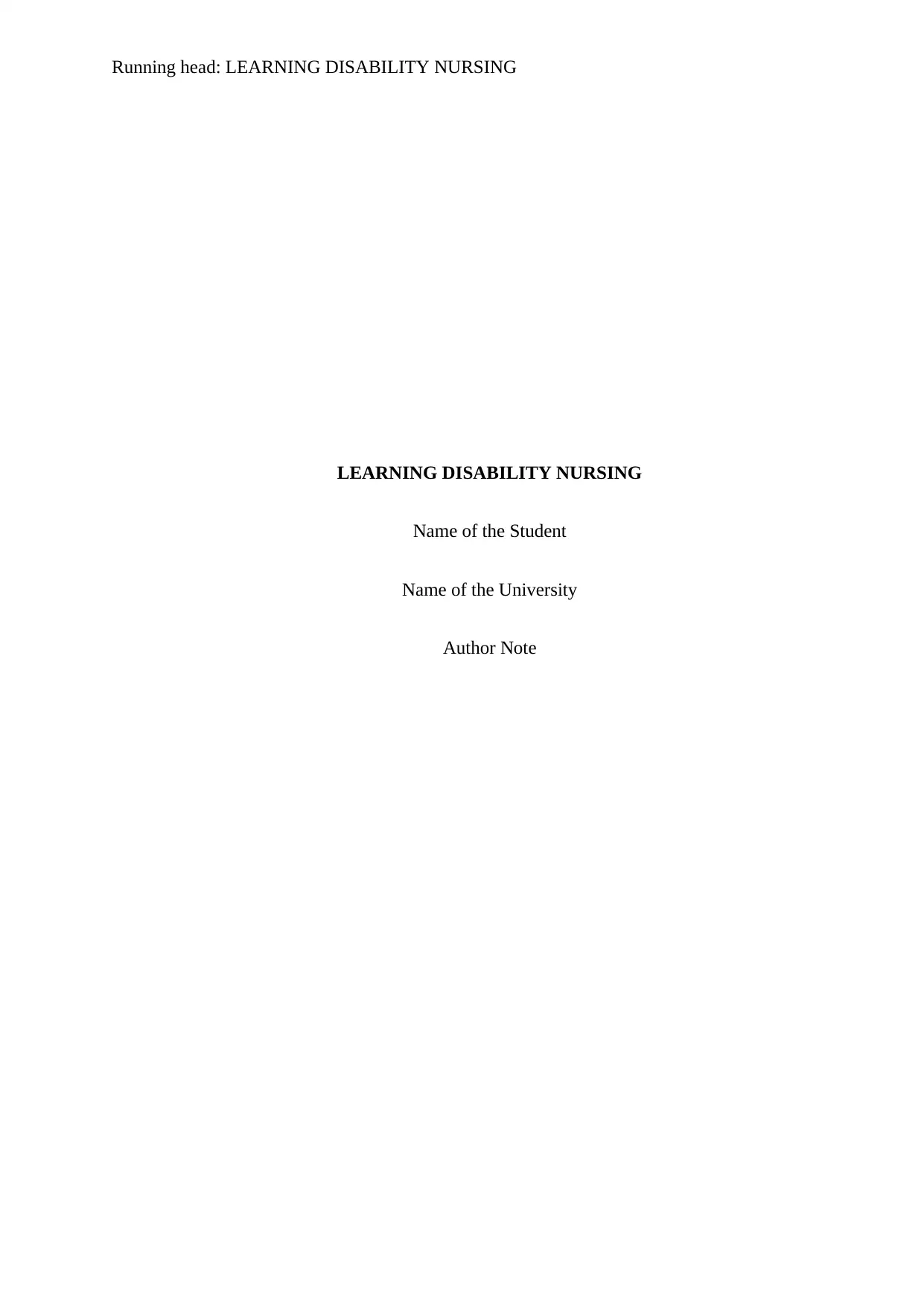
Running head: LEARNING DISABILITY NURSING
LEARNING DISABILITY NURSING
Name of the Student
Name of the University
Author Note
LEARNING DISABILITY NURSING
Name of the Student
Name of the University
Author Note
Secure Best Marks with AI Grader
Need help grading? Try our AI Grader for instant feedback on your assignments.
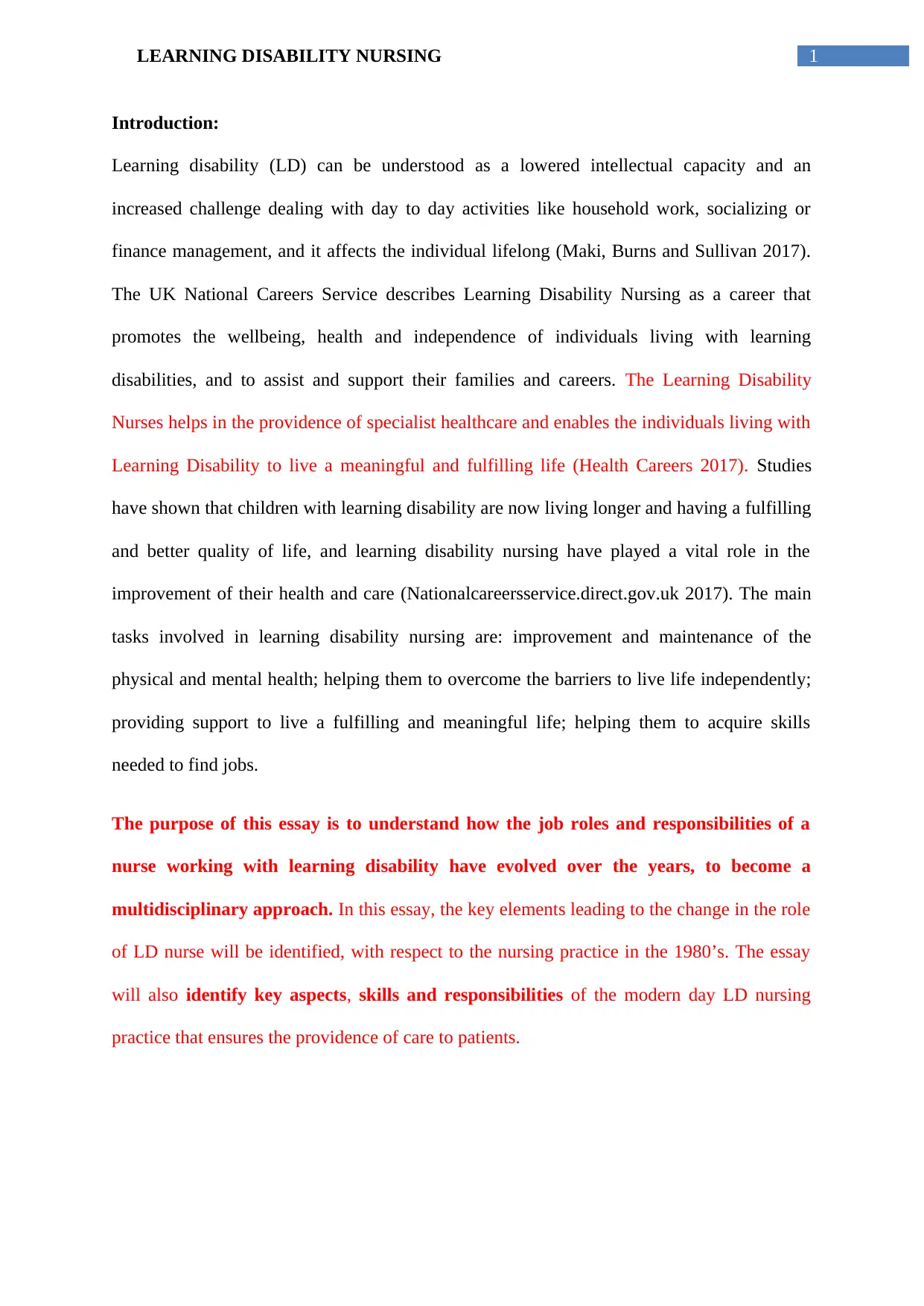
1LEARNING DISABILITY NURSING
Introduction:
Learning disability (LD) can be understood as a lowered intellectual capacity and an
increased challenge dealing with day to day activities like household work, socializing or
finance management, and it affects the individual lifelong (Maki, Burns and Sullivan 2017).
The UK National Careers Service describes Learning Disability Nursing as a career that
promotes the wellbeing, health and independence of individuals living with learning
disabilities, and to assist and support their families and careers. The Learning Disability
Nurses helps in the providence of specialist healthcare and enables the individuals living with
Learning Disability to live a meaningful and fulfilling life (Health Careers 2017). Studies
have shown that children with learning disability are now living longer and having a fulfilling
and better quality of life, and learning disability nursing have played a vital role in the
improvement of their health and care (Nationalcareersservice.direct.gov.uk 2017). The main
tasks involved in learning disability nursing are: improvement and maintenance of the
physical and mental health; helping them to overcome the barriers to live life independently;
providing support to live a fulfilling and meaningful life; helping them to acquire skills
needed to find jobs.
The purpose of this essay is to understand how the job roles and responsibilities of a
nurse working with learning disability have evolved over the years, to become a
multidisciplinary approach. In this essay, the key elements leading to the change in the role
of LD nurse will be identified, with respect to the nursing practice in the 1980’s. The essay
will also identify key aspects, skills and responsibilities of the modern day LD nursing
practice that ensures the providence of care to patients.
Introduction:
Learning disability (LD) can be understood as a lowered intellectual capacity and an
increased challenge dealing with day to day activities like household work, socializing or
finance management, and it affects the individual lifelong (Maki, Burns and Sullivan 2017).
The UK National Careers Service describes Learning Disability Nursing as a career that
promotes the wellbeing, health and independence of individuals living with learning
disabilities, and to assist and support their families and careers. The Learning Disability
Nurses helps in the providence of specialist healthcare and enables the individuals living with
Learning Disability to live a meaningful and fulfilling life (Health Careers 2017). Studies
have shown that children with learning disability are now living longer and having a fulfilling
and better quality of life, and learning disability nursing have played a vital role in the
improvement of their health and care (Nationalcareersservice.direct.gov.uk 2017). The main
tasks involved in learning disability nursing are: improvement and maintenance of the
physical and mental health; helping them to overcome the barriers to live life independently;
providing support to live a fulfilling and meaningful life; helping them to acquire skills
needed to find jobs.
The purpose of this essay is to understand how the job roles and responsibilities of a
nurse working with learning disability have evolved over the years, to become a
multidisciplinary approach. In this essay, the key elements leading to the change in the role
of LD nurse will be identified, with respect to the nursing practice in the 1980’s. The essay
will also identify key aspects, skills and responsibilities of the modern day LD nursing
practice that ensures the providence of care to patients.
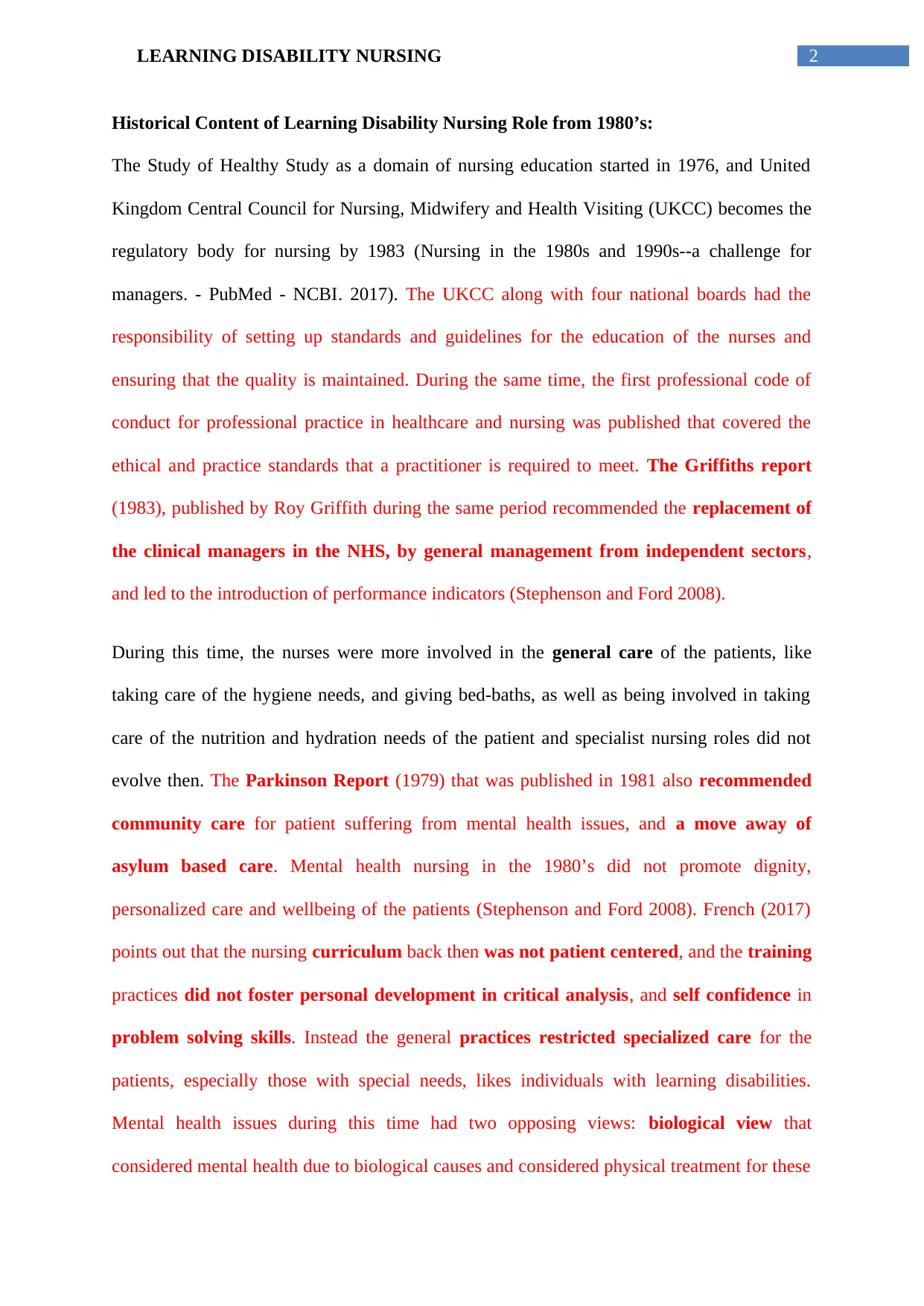
2LEARNING DISABILITY NURSING
Historical Content of Learning Disability Nursing Role from 1980’s:
The Study of Healthy Study as a domain of nursing education started in 1976, and United
Kingdom Central Council for Nursing, Midwifery and Health Visiting (UKCC) becomes the
regulatory body for nursing by 1983 (Nursing in the 1980s and 1990s--a challenge for
managers. - PubMed - NCBI. 2017). The UKCC along with four national boards had the
responsibility of setting up standards and guidelines for the education of the nurses and
ensuring that the quality is maintained. During the same time, the first professional code of
conduct for professional practice in healthcare and nursing was published that covered the
ethical and practice standards that a practitioner is required to meet. The Griffiths report
(1983), published by Roy Griffith during the same period recommended the replacement of
the clinical managers in the NHS, by general management from independent sectors,
and led to the introduction of performance indicators (Stephenson and Ford 2008).
During this time, the nurses were more involved in the general care of the patients, like
taking care of the hygiene needs, and giving bed-baths, as well as being involved in taking
care of the nutrition and hydration needs of the patient and specialist nursing roles did not
evolve then. The Parkinson Report (1979) that was published in 1981 also recommended
community care for patient suffering from mental health issues, and a move away of
asylum based care. Mental health nursing in the 1980’s did not promote dignity,
personalized care and wellbeing of the patients (Stephenson and Ford 2008). French (2017)
points out that the nursing curriculum back then was not patient centered, and the training
practices did not foster personal development in critical analysis, and self confidence in
problem solving skills. Instead the general practices restricted specialized care for the
patients, especially those with special needs, likes individuals with learning disabilities.
Mental health issues during this time had two opposing views: biological view that
considered mental health due to biological causes and considered physical treatment for these
Historical Content of Learning Disability Nursing Role from 1980’s:
The Study of Healthy Study as a domain of nursing education started in 1976, and United
Kingdom Central Council for Nursing, Midwifery and Health Visiting (UKCC) becomes the
regulatory body for nursing by 1983 (Nursing in the 1980s and 1990s--a challenge for
managers. - PubMed - NCBI. 2017). The UKCC along with four national boards had the
responsibility of setting up standards and guidelines for the education of the nurses and
ensuring that the quality is maintained. During the same time, the first professional code of
conduct for professional practice in healthcare and nursing was published that covered the
ethical and practice standards that a practitioner is required to meet. The Griffiths report
(1983), published by Roy Griffith during the same period recommended the replacement of
the clinical managers in the NHS, by general management from independent sectors,
and led to the introduction of performance indicators (Stephenson and Ford 2008).
During this time, the nurses were more involved in the general care of the patients, like
taking care of the hygiene needs, and giving bed-baths, as well as being involved in taking
care of the nutrition and hydration needs of the patient and specialist nursing roles did not
evolve then. The Parkinson Report (1979) that was published in 1981 also recommended
community care for patient suffering from mental health issues, and a move away of
asylum based care. Mental health nursing in the 1980’s did not promote dignity,
personalized care and wellbeing of the patients (Stephenson and Ford 2008). French (2017)
points out that the nursing curriculum back then was not patient centered, and the training
practices did not foster personal development in critical analysis, and self confidence in
problem solving skills. Instead the general practices restricted specialized care for the
patients, especially those with special needs, likes individuals with learning disabilities.
Mental health issues during this time had two opposing views: biological view that
considered mental health due to biological causes and considered physical treatment for these
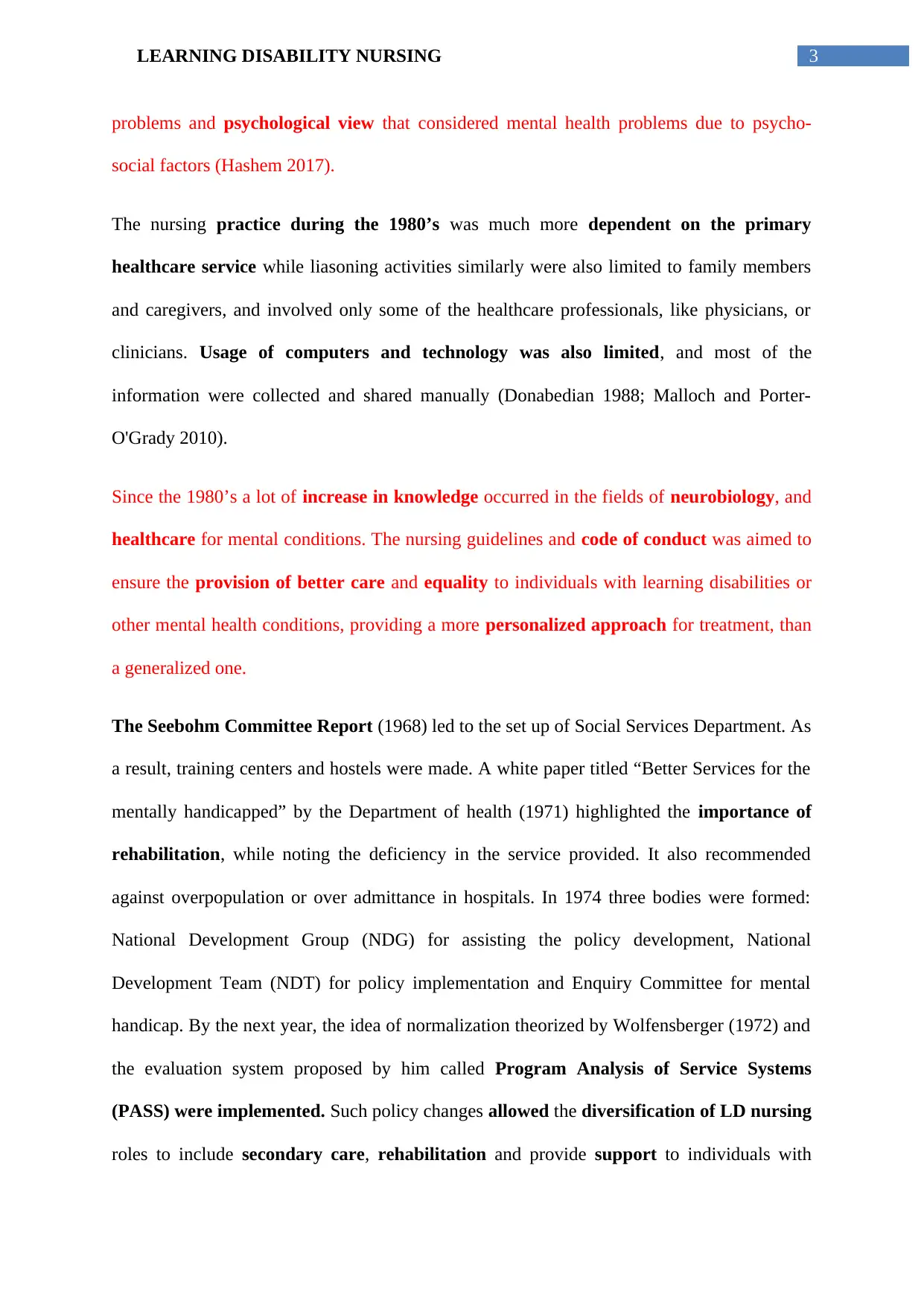
3LEARNING DISABILITY NURSING
problems and psychological view that considered mental health problems due to psycho-
social factors (Hashem 2017).
The nursing practice during the 1980’s was much more dependent on the primary
healthcare service while liasoning activities similarly were also limited to family members
and caregivers, and involved only some of the healthcare professionals, like physicians, or
clinicians. Usage of computers and technology was also limited, and most of the
information were collected and shared manually (Donabedian 1988; Malloch and Porter-
O'Grady 2010).
Since the 1980’s a lot of increase in knowledge occurred in the fields of neurobiology, and
healthcare for mental conditions. The nursing guidelines and code of conduct was aimed to
ensure the provision of better care and equality to individuals with learning disabilities or
other mental health conditions, providing a more personalized approach for treatment, than
a generalized one.
The Seebohm Committee Report (1968) led to the set up of Social Services Department. As
a result, training centers and hostels were made. A white paper titled “Better Services for the
mentally handicapped” by the Department of health (1971) highlighted the importance of
rehabilitation, while noting the deficiency in the service provided. It also recommended
against overpopulation or over admittance in hospitals. In 1974 three bodies were formed:
National Development Group (NDG) for assisting the policy development, National
Development Team (NDT) for policy implementation and Enquiry Committee for mental
handicap. By the next year, the idea of normalization theorized by Wolfensberger (1972) and
the evaluation system proposed by him called Program Analysis of Service Systems
(PASS) were implemented. Such policy changes allowed the diversification of LD nursing
roles to include secondary care, rehabilitation and provide support to individuals with
problems and psychological view that considered mental health problems due to psycho-
social factors (Hashem 2017).
The nursing practice during the 1980’s was much more dependent on the primary
healthcare service while liasoning activities similarly were also limited to family members
and caregivers, and involved only some of the healthcare professionals, like physicians, or
clinicians. Usage of computers and technology was also limited, and most of the
information were collected and shared manually (Donabedian 1988; Malloch and Porter-
O'Grady 2010).
Since the 1980’s a lot of increase in knowledge occurred in the fields of neurobiology, and
healthcare for mental conditions. The nursing guidelines and code of conduct was aimed to
ensure the provision of better care and equality to individuals with learning disabilities or
other mental health conditions, providing a more personalized approach for treatment, than
a generalized one.
The Seebohm Committee Report (1968) led to the set up of Social Services Department. As
a result, training centers and hostels were made. A white paper titled “Better Services for the
mentally handicapped” by the Department of health (1971) highlighted the importance of
rehabilitation, while noting the deficiency in the service provided. It also recommended
against overpopulation or over admittance in hospitals. In 1974 three bodies were formed:
National Development Group (NDG) for assisting the policy development, National
Development Team (NDT) for policy implementation and Enquiry Committee for mental
handicap. By the next year, the idea of normalization theorized by Wolfensberger (1972) and
the evaluation system proposed by him called Program Analysis of Service Systems
(PASS) were implemented. Such policy changes allowed the diversification of LD nursing
roles to include secondary care, rehabilitation and provide support to individuals with
Secure Best Marks with AI Grader
Need help grading? Try our AI Grader for instant feedback on your assignments.
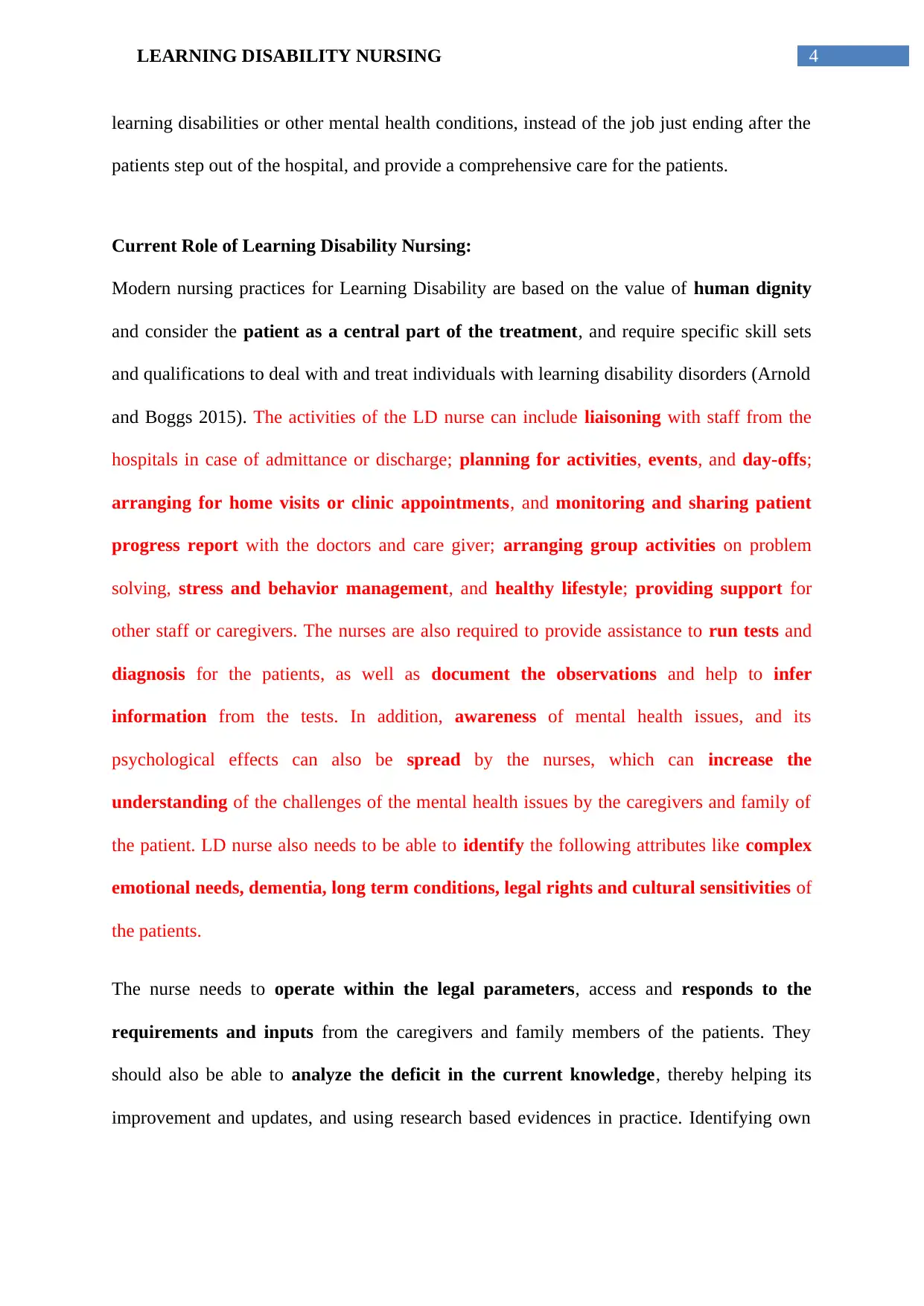
4LEARNING DISABILITY NURSING
learning disabilities or other mental health conditions, instead of the job just ending after the
patients step out of the hospital, and provide a comprehensive care for the patients.
Current Role of Learning Disability Nursing:
Modern nursing practices for Learning Disability are based on the value of human dignity
and consider the patient as a central part of the treatment, and require specific skill sets
and qualifications to deal with and treat individuals with learning disability disorders (Arnold
and Boggs 2015). The activities of the LD nurse can include liaisoning with staff from the
hospitals in case of admittance or discharge; planning for activities, events, and day-offs;
arranging for home visits or clinic appointments, and monitoring and sharing patient
progress report with the doctors and care giver; arranging group activities on problem
solving, stress and behavior management, and healthy lifestyle; providing support for
other staff or caregivers. The nurses are also required to provide assistance to run tests and
diagnosis for the patients, as well as document the observations and help to infer
information from the tests. In addition, awareness of mental health issues, and its
psychological effects can also be spread by the nurses, which can increase the
understanding of the challenges of the mental health issues by the caregivers and family of
the patient. LD nurse also needs to be able to identify the following attributes like complex
emotional needs, dementia, long term conditions, legal rights and cultural sensitivities of
the patients.
The nurse needs to operate within the legal parameters, access and responds to the
requirements and inputs from the caregivers and family members of the patients. They
should also be able to analyze the deficit in the current knowledge, thereby helping its
improvement and updates, and using research based evidences in practice. Identifying own
learning disabilities or other mental health conditions, instead of the job just ending after the
patients step out of the hospital, and provide a comprehensive care for the patients.
Current Role of Learning Disability Nursing:
Modern nursing practices for Learning Disability are based on the value of human dignity
and consider the patient as a central part of the treatment, and require specific skill sets
and qualifications to deal with and treat individuals with learning disability disorders (Arnold
and Boggs 2015). The activities of the LD nurse can include liaisoning with staff from the
hospitals in case of admittance or discharge; planning for activities, events, and day-offs;
arranging for home visits or clinic appointments, and monitoring and sharing patient
progress report with the doctors and care giver; arranging group activities on problem
solving, stress and behavior management, and healthy lifestyle; providing support for
other staff or caregivers. The nurses are also required to provide assistance to run tests and
diagnosis for the patients, as well as document the observations and help to infer
information from the tests. In addition, awareness of mental health issues, and its
psychological effects can also be spread by the nurses, which can increase the
understanding of the challenges of the mental health issues by the caregivers and family of
the patient. LD nurse also needs to be able to identify the following attributes like complex
emotional needs, dementia, long term conditions, legal rights and cultural sensitivities of
the patients.
The nurse needs to operate within the legal parameters, access and responds to the
requirements and inputs from the caregivers and family members of the patients. They
should also be able to analyze the deficit in the current knowledge, thereby helping its
improvement and updates, and using research based evidences in practice. Identifying own
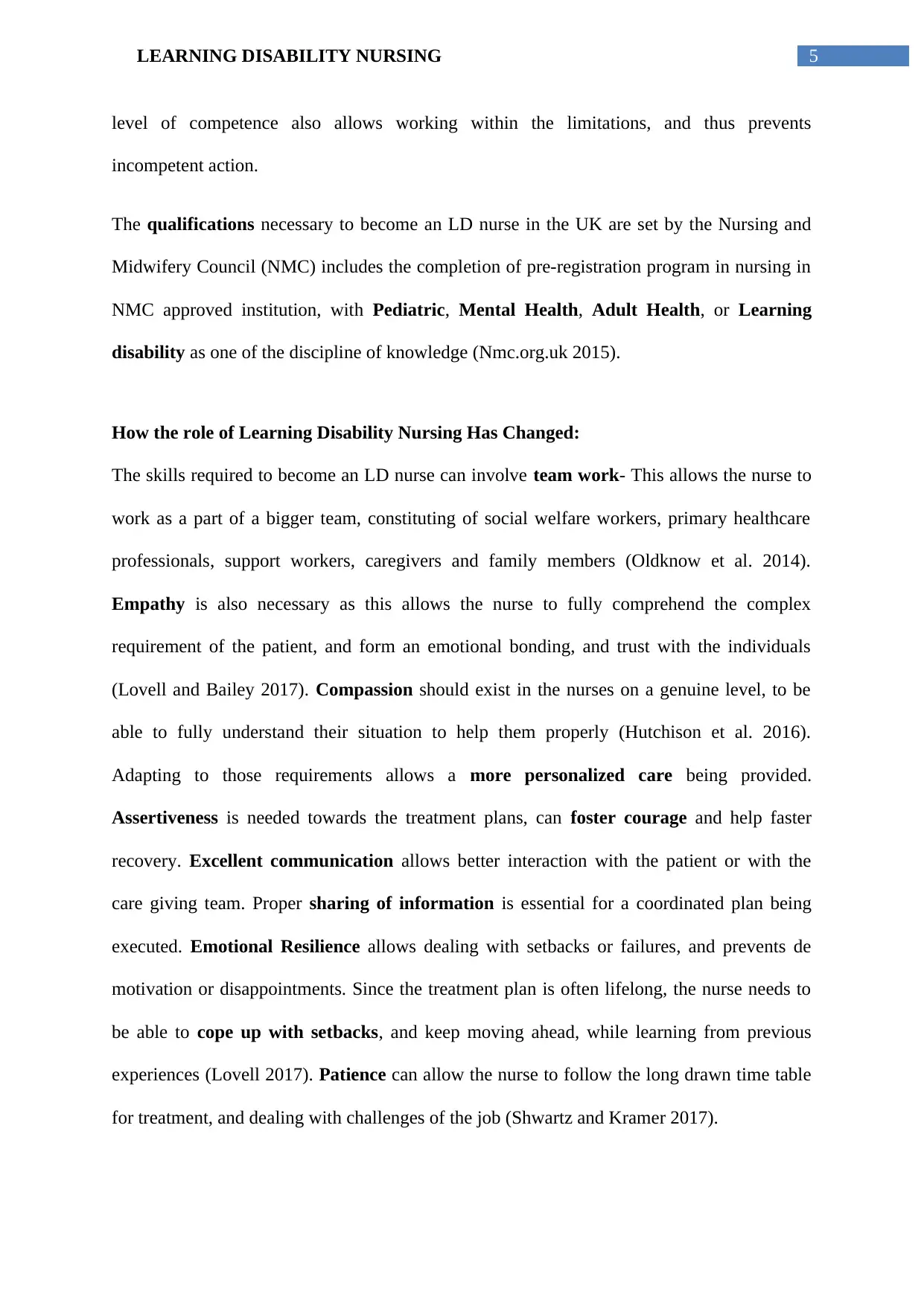
5LEARNING DISABILITY NURSING
level of competence also allows working within the limitations, and thus prevents
incompetent action.
The qualifications necessary to become an LD nurse in the UK are set by the Nursing and
Midwifery Council (NMC) includes the completion of pre-registration program in nursing in
NMC approved institution, with Pediatric, Mental Health, Adult Health, or Learning
disability as one of the discipline of knowledge (Nmc.org.uk 2015).
How the role of Learning Disability Nursing Has Changed:
The skills required to become an LD nurse can involve team work- This allows the nurse to
work as a part of a bigger team, constituting of social welfare workers, primary healthcare
professionals, support workers, caregivers and family members (Oldknow et al. 2014).
Empathy is also necessary as this allows the nurse to fully comprehend the complex
requirement of the patient, and form an emotional bonding, and trust with the individuals
(Lovell and Bailey 2017). Compassion should exist in the nurses on a genuine level, to be
able to fully understand their situation to help them properly (Hutchison et al. 2016).
Adapting to those requirements allows a more personalized care being provided.
Assertiveness is needed towards the treatment plans, can foster courage and help faster
recovery. Excellent communication allows better interaction with the patient or with the
care giving team. Proper sharing of information is essential for a coordinated plan being
executed. Emotional Resilience allows dealing with setbacks or failures, and prevents de
motivation or disappointments. Since the treatment plan is often lifelong, the nurse needs to
be able to cope up with setbacks, and keep moving ahead, while learning from previous
experiences (Lovell 2017). Patience can allow the nurse to follow the long drawn time table
for treatment, and dealing with challenges of the job (Shwartz and Kramer 2017).
level of competence also allows working within the limitations, and thus prevents
incompetent action.
The qualifications necessary to become an LD nurse in the UK are set by the Nursing and
Midwifery Council (NMC) includes the completion of pre-registration program in nursing in
NMC approved institution, with Pediatric, Mental Health, Adult Health, or Learning
disability as one of the discipline of knowledge (Nmc.org.uk 2015).
How the role of Learning Disability Nursing Has Changed:
The skills required to become an LD nurse can involve team work- This allows the nurse to
work as a part of a bigger team, constituting of social welfare workers, primary healthcare
professionals, support workers, caregivers and family members (Oldknow et al. 2014).
Empathy is also necessary as this allows the nurse to fully comprehend the complex
requirement of the patient, and form an emotional bonding, and trust with the individuals
(Lovell and Bailey 2017). Compassion should exist in the nurses on a genuine level, to be
able to fully understand their situation to help them properly (Hutchison et al. 2016).
Adapting to those requirements allows a more personalized care being provided.
Assertiveness is needed towards the treatment plans, can foster courage and help faster
recovery. Excellent communication allows better interaction with the patient or with the
care giving team. Proper sharing of information is essential for a coordinated plan being
executed. Emotional Resilience allows dealing with setbacks or failures, and prevents de
motivation or disappointments. Since the treatment plan is often lifelong, the nurse needs to
be able to cope up with setbacks, and keep moving ahead, while learning from previous
experiences (Lovell 2017). Patience can allow the nurse to follow the long drawn time table
for treatment, and dealing with challenges of the job (Shwartz and Kramer 2017).
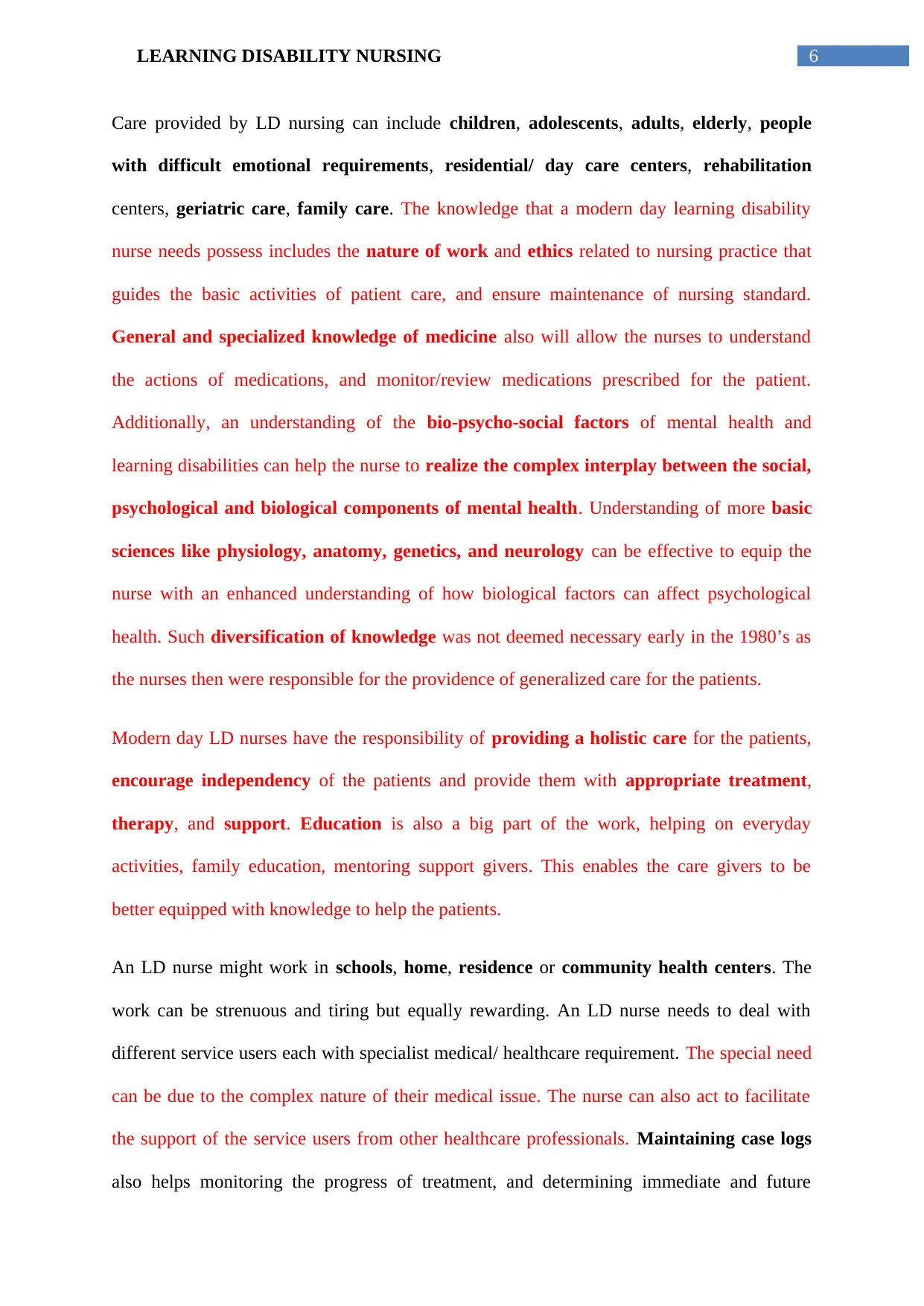
6LEARNING DISABILITY NURSING
Care provided by LD nursing can include children, adolescents, adults, elderly, people
with difficult emotional requirements, residential/ day care centers, rehabilitation
centers, geriatric care, family care. The knowledge that a modern day learning disability
nurse needs possess includes the nature of work and ethics related to nursing practice that
guides the basic activities of patient care, and ensure maintenance of nursing standard.
General and specialized knowledge of medicine also will allow the nurses to understand
the actions of medications, and monitor/review medications prescribed for the patient.
Additionally, an understanding of the bio-psycho-social factors of mental health and
learning disabilities can help the nurse to realize the complex interplay between the social,
psychological and biological components of mental health. Understanding of more basic
sciences like physiology, anatomy, genetics, and neurology can be effective to equip the
nurse with an enhanced understanding of how biological factors can affect psychological
health. Such diversification of knowledge was not deemed necessary early in the 1980’s as
the nurses then were responsible for the providence of generalized care for the patients.
Modern day LD nurses have the responsibility of providing a holistic care for the patients,
encourage independency of the patients and provide them with appropriate treatment,
therapy, and support. Education is also a big part of the work, helping on everyday
activities, family education, mentoring support givers. This enables the care givers to be
better equipped with knowledge to help the patients.
An LD nurse might work in schools, home, residence or community health centers. The
work can be strenuous and tiring but equally rewarding. An LD nurse needs to deal with
different service users each with specialist medical/ healthcare requirement. The special need
can be due to the complex nature of their medical issue. The nurse can also act to facilitate
the support of the service users from other healthcare professionals. Maintaining case logs
also helps monitoring the progress of treatment, and determining immediate and future
Care provided by LD nursing can include children, adolescents, adults, elderly, people
with difficult emotional requirements, residential/ day care centers, rehabilitation
centers, geriatric care, family care. The knowledge that a modern day learning disability
nurse needs possess includes the nature of work and ethics related to nursing practice that
guides the basic activities of patient care, and ensure maintenance of nursing standard.
General and specialized knowledge of medicine also will allow the nurses to understand
the actions of medications, and monitor/review medications prescribed for the patient.
Additionally, an understanding of the bio-psycho-social factors of mental health and
learning disabilities can help the nurse to realize the complex interplay between the social,
psychological and biological components of mental health. Understanding of more basic
sciences like physiology, anatomy, genetics, and neurology can be effective to equip the
nurse with an enhanced understanding of how biological factors can affect psychological
health. Such diversification of knowledge was not deemed necessary early in the 1980’s as
the nurses then were responsible for the providence of generalized care for the patients.
Modern day LD nurses have the responsibility of providing a holistic care for the patients,
encourage independency of the patients and provide them with appropriate treatment,
therapy, and support. Education is also a big part of the work, helping on everyday
activities, family education, mentoring support givers. This enables the care givers to be
better equipped with knowledge to help the patients.
An LD nurse might work in schools, home, residence or community health centers. The
work can be strenuous and tiring but equally rewarding. An LD nurse needs to deal with
different service users each with specialist medical/ healthcare requirement. The special need
can be due to the complex nature of their medical issue. The nurse can also act to facilitate
the support of the service users from other healthcare professionals. Maintaining case logs
also helps monitoring the progress of treatment, and determining immediate and future
Paraphrase This Document
Need a fresh take? Get an instant paraphrase of this document with our AI Paraphraser
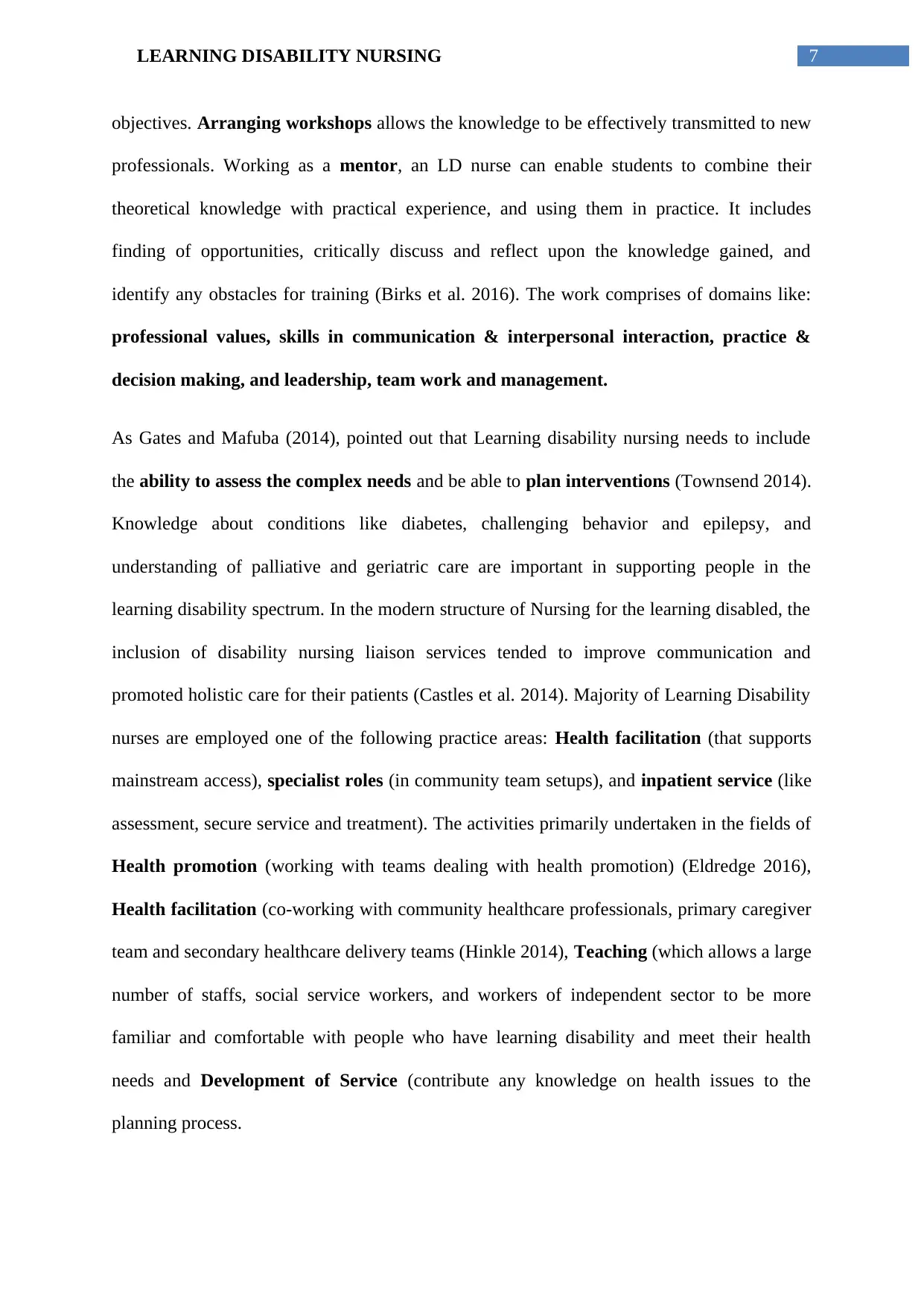
7LEARNING DISABILITY NURSING
objectives. Arranging workshops allows the knowledge to be effectively transmitted to new
professionals. Working as a mentor, an LD nurse can enable students to combine their
theoretical knowledge with practical experience, and using them in practice. It includes
finding of opportunities, critically discuss and reflect upon the knowledge gained, and
identify any obstacles for training (Birks et al. 2016). The work comprises of domains like:
professional values, skills in communication & interpersonal interaction, practice &
decision making, and leadership, team work and management.
As Gates and Mafuba (2014), pointed out that Learning disability nursing needs to include
the ability to assess the complex needs and be able to plan interventions (Townsend 2014).
Knowledge about conditions like diabetes, challenging behavior and epilepsy, and
understanding of palliative and geriatric care are important in supporting people in the
learning disability spectrum. In the modern structure of Nursing for the learning disabled, the
inclusion of disability nursing liaison services tended to improve communication and
promoted holistic care for their patients (Castles et al. 2014). Majority of Learning Disability
nurses are employed one of the following practice areas: Health facilitation (that supports
mainstream access), specialist roles (in community team setups), and inpatient service (like
assessment, secure service and treatment). The activities primarily undertaken in the fields of
Health promotion (working with teams dealing with health promotion) (Eldredge 2016),
Health facilitation (co-working with community healthcare professionals, primary caregiver
team and secondary healthcare delivery teams (Hinkle 2014), Teaching (which allows a large
number of staffs, social service workers, and workers of independent sector to be more
familiar and comfortable with people who have learning disability and meet their health
needs and Development of Service (contribute any knowledge on health issues to the
planning process.
objectives. Arranging workshops allows the knowledge to be effectively transmitted to new
professionals. Working as a mentor, an LD nurse can enable students to combine their
theoretical knowledge with practical experience, and using them in practice. It includes
finding of opportunities, critically discuss and reflect upon the knowledge gained, and
identify any obstacles for training (Birks et al. 2016). The work comprises of domains like:
professional values, skills in communication & interpersonal interaction, practice &
decision making, and leadership, team work and management.
As Gates and Mafuba (2014), pointed out that Learning disability nursing needs to include
the ability to assess the complex needs and be able to plan interventions (Townsend 2014).
Knowledge about conditions like diabetes, challenging behavior and epilepsy, and
understanding of palliative and geriatric care are important in supporting people in the
learning disability spectrum. In the modern structure of Nursing for the learning disabled, the
inclusion of disability nursing liaison services tended to improve communication and
promoted holistic care for their patients (Castles et al. 2014). Majority of Learning Disability
nurses are employed one of the following practice areas: Health facilitation (that supports
mainstream access), specialist roles (in community team setups), and inpatient service (like
assessment, secure service and treatment). The activities primarily undertaken in the fields of
Health promotion (working with teams dealing with health promotion) (Eldredge 2016),
Health facilitation (co-working with community healthcare professionals, primary caregiver
team and secondary healthcare delivery teams (Hinkle 2014), Teaching (which allows a large
number of staffs, social service workers, and workers of independent sector to be more
familiar and comfortable with people who have learning disability and meet their health
needs and Development of Service (contribute any knowledge on health issues to the
planning process.
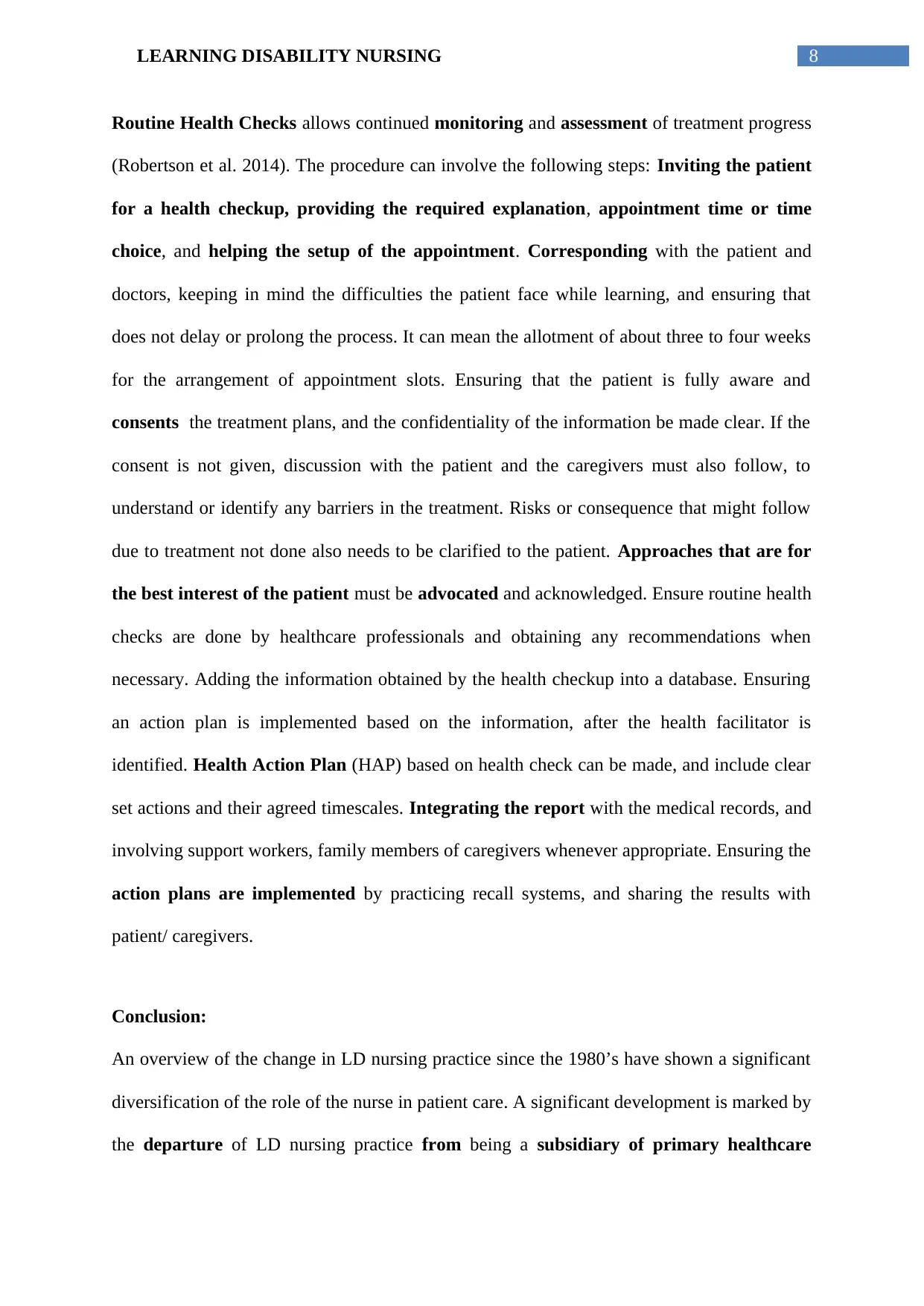
8LEARNING DISABILITY NURSING
Routine Health Checks allows continued monitoring and assessment of treatment progress
(Robertson et al. 2014). The procedure can involve the following steps: Inviting the patient
for a health checkup, providing the required explanation, appointment time or time
choice, and helping the setup of the appointment. Corresponding with the patient and
doctors, keeping in mind the difficulties the patient face while learning, and ensuring that
does not delay or prolong the process. It can mean the allotment of about three to four weeks
for the arrangement of appointment slots. Ensuring that the patient is fully aware and
consents the treatment plans, and the confidentiality of the information be made clear. If the
consent is not given, discussion with the patient and the caregivers must also follow, to
understand or identify any barriers in the treatment. Risks or consequence that might follow
due to treatment not done also needs to be clarified to the patient. Approaches that are for
the best interest of the patient must be advocated and acknowledged. Ensure routine health
checks are done by healthcare professionals and obtaining any recommendations when
necessary. Adding the information obtained by the health checkup into a database. Ensuring
an action plan is implemented based on the information, after the health facilitator is
identified. Health Action Plan (HAP) based on health check can be made, and include clear
set actions and their agreed timescales. Integrating the report with the medical records, and
involving support workers, family members of caregivers whenever appropriate. Ensuring the
action plans are implemented by practicing recall systems, and sharing the results with
patient/ caregivers.
Conclusion:
An overview of the change in LD nursing practice since the 1980’s have shown a significant
diversification of the role of the nurse in patient care. A significant development is marked by
the departure of LD nursing practice from being a subsidiary of primary healthcare
Routine Health Checks allows continued monitoring and assessment of treatment progress
(Robertson et al. 2014). The procedure can involve the following steps: Inviting the patient
for a health checkup, providing the required explanation, appointment time or time
choice, and helping the setup of the appointment. Corresponding with the patient and
doctors, keeping in mind the difficulties the patient face while learning, and ensuring that
does not delay or prolong the process. It can mean the allotment of about three to four weeks
for the arrangement of appointment slots. Ensuring that the patient is fully aware and
consents the treatment plans, and the confidentiality of the information be made clear. If the
consent is not given, discussion with the patient and the caregivers must also follow, to
understand or identify any barriers in the treatment. Risks or consequence that might follow
due to treatment not done also needs to be clarified to the patient. Approaches that are for
the best interest of the patient must be advocated and acknowledged. Ensure routine health
checks are done by healthcare professionals and obtaining any recommendations when
necessary. Adding the information obtained by the health checkup into a database. Ensuring
an action plan is implemented based on the information, after the health facilitator is
identified. Health Action Plan (HAP) based on health check can be made, and include clear
set actions and their agreed timescales. Integrating the report with the medical records, and
involving support workers, family members of caregivers whenever appropriate. Ensuring the
action plans are implemented by practicing recall systems, and sharing the results with
patient/ caregivers.
Conclusion:
An overview of the change in LD nursing practice since the 1980’s have shown a significant
diversification of the role of the nurse in patient care. A significant development is marked by
the departure of LD nursing practice from being a subsidiary of primary healthcare
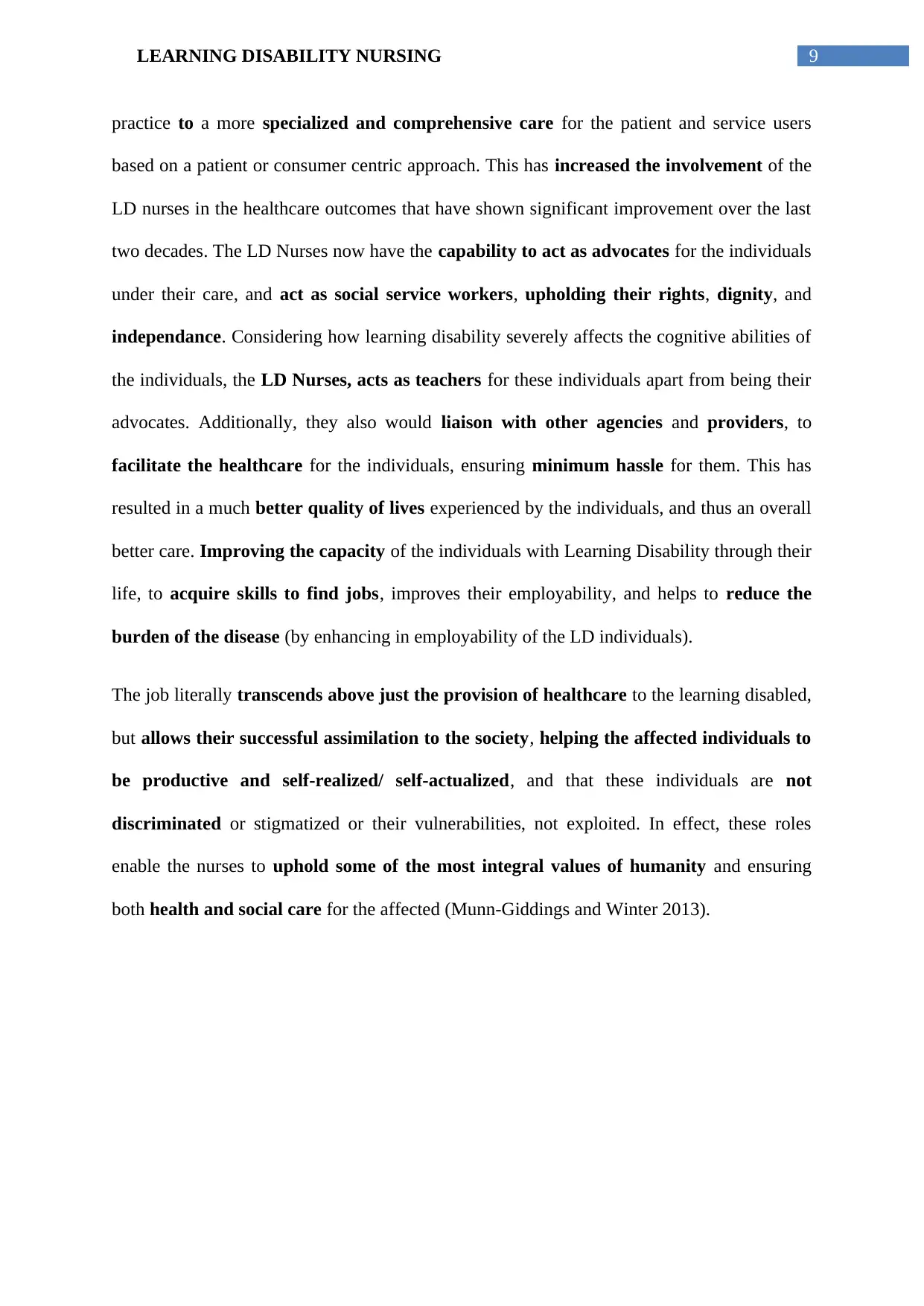
9LEARNING DISABILITY NURSING
practice to a more specialized and comprehensive care for the patient and service users
based on a patient or consumer centric approach. This has increased the involvement of the
LD nurses in the healthcare outcomes that have shown significant improvement over the last
two decades. The LD Nurses now have the capability to act as advocates for the individuals
under their care, and act as social service workers, upholding their rights, dignity, and
independance. Considering how learning disability severely affects the cognitive abilities of
the individuals, the LD Nurses, acts as teachers for these individuals apart from being their
advocates. Additionally, they also would liaison with other agencies and providers, to
facilitate the healthcare for the individuals, ensuring minimum hassle for them. This has
resulted in a much better quality of lives experienced by the individuals, and thus an overall
better care. Improving the capacity of the individuals with Learning Disability through their
life, to acquire skills to find jobs, improves their employability, and helps to reduce the
burden of the disease (by enhancing in employability of the LD individuals).
The job literally transcends above just the provision of healthcare to the learning disabled,
but allows their successful assimilation to the society, helping the affected individuals to
be productive and self-realized/ self-actualized, and that these individuals are not
discriminated or stigmatized or their vulnerabilities, not exploited. In effect, these roles
enable the nurses to uphold some of the most integral values of humanity and ensuring
both health and social care for the affected (Munn-Giddings and Winter 2013).
practice to a more specialized and comprehensive care for the patient and service users
based on a patient or consumer centric approach. This has increased the involvement of the
LD nurses in the healthcare outcomes that have shown significant improvement over the last
two decades. The LD Nurses now have the capability to act as advocates for the individuals
under their care, and act as social service workers, upholding their rights, dignity, and
independance. Considering how learning disability severely affects the cognitive abilities of
the individuals, the LD Nurses, acts as teachers for these individuals apart from being their
advocates. Additionally, they also would liaison with other agencies and providers, to
facilitate the healthcare for the individuals, ensuring minimum hassle for them. This has
resulted in a much better quality of lives experienced by the individuals, and thus an overall
better care. Improving the capacity of the individuals with Learning Disability through their
life, to acquire skills to find jobs, improves their employability, and helps to reduce the
burden of the disease (by enhancing in employability of the LD individuals).
The job literally transcends above just the provision of healthcare to the learning disabled,
but allows their successful assimilation to the society, helping the affected individuals to
be productive and self-realized/ self-actualized, and that these individuals are not
discriminated or stigmatized or their vulnerabilities, not exploited. In effect, these roles
enable the nurses to uphold some of the most integral values of humanity and ensuring
both health and social care for the affected (Munn-Giddings and Winter 2013).
Secure Best Marks with AI Grader
Need help grading? Try our AI Grader for instant feedback on your assignments.
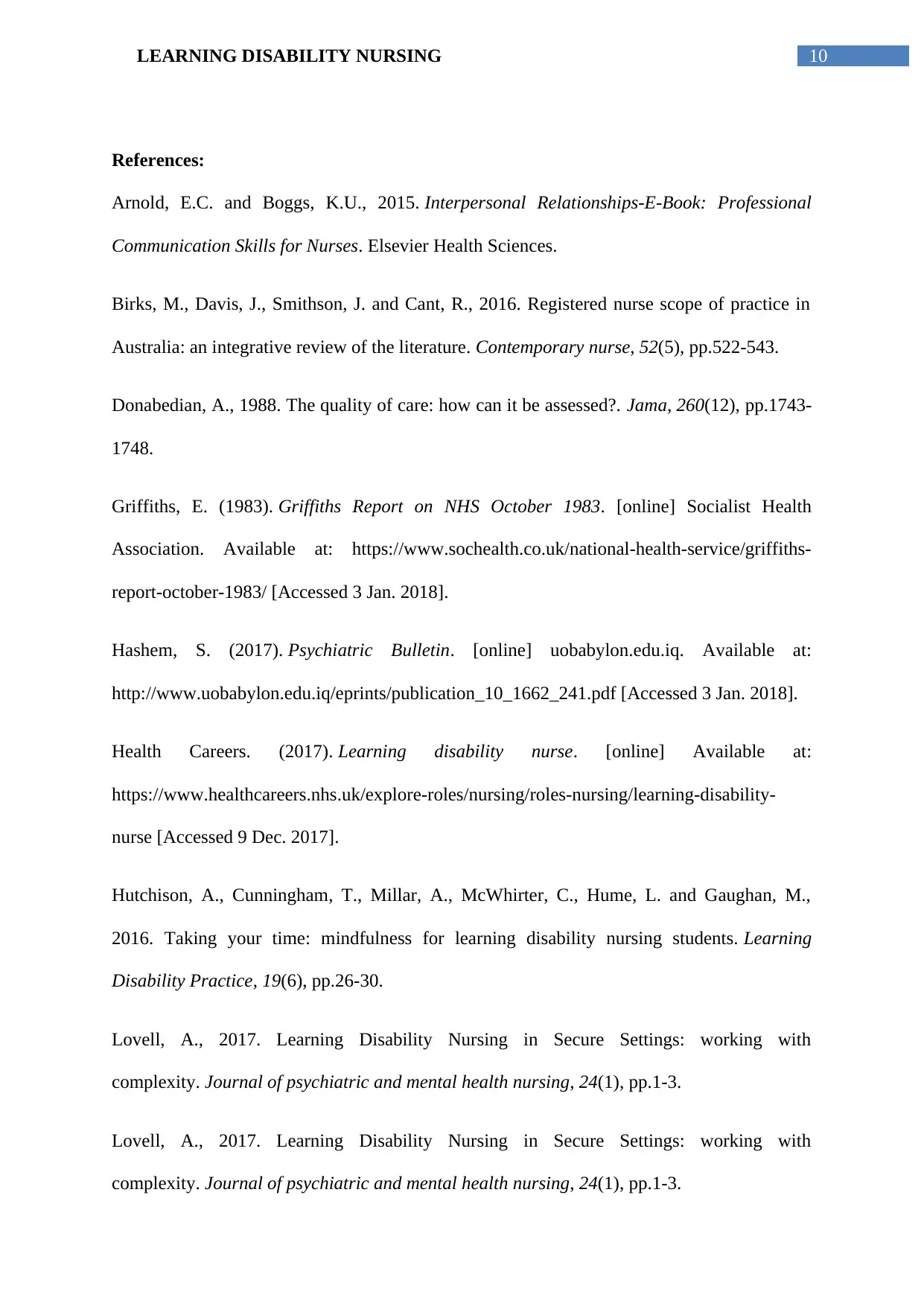
10LEARNING DISABILITY NURSING
References:
Arnold, E.C. and Boggs, K.U., 2015. Interpersonal Relationships-E-Book: Professional
Communication Skills for Nurses. Elsevier Health Sciences.
Birks, M., Davis, J., Smithson, J. and Cant, R., 2016. Registered nurse scope of practice in
Australia: an integrative review of the literature. Contemporary nurse, 52(5), pp.522-543.
Donabedian, A., 1988. The quality of care: how can it be assessed?. Jama, 260(12), pp.1743-
1748.
Griffiths, E. (1983). Griffiths Report on NHS October 1983. [online] Socialist Health
Association. Available at: https://www.sochealth.co.uk/national-health-service/griffiths-
report-october-1983/ [Accessed 3 Jan. 2018].
Hashem, S. (2017). Psychiatric Bulletin. [online] uobabylon.edu.iq. Available at:
http://www.uobabylon.edu.iq/eprints/publication_10_1662_241.pdf [Accessed 3 Jan. 2018].
Health Careers. (2017). Learning disability nurse. [online] Available at:
https://www.healthcareers.nhs.uk/explore-roles/nursing/roles-nursing/learning-disability-
nurse [Accessed 9 Dec. 2017].
Hutchison, A., Cunningham, T., Millar, A., McWhirter, C., Hume, L. and Gaughan, M.,
2016. Taking your time: mindfulness for learning disability nursing students. Learning
Disability Practice, 19(6), pp.26-30.
Lovell, A., 2017. Learning Disability Nursing in Secure Settings: working with
complexity. Journal of psychiatric and mental health nursing, 24(1), pp.1-3.
Lovell, A., 2017. Learning Disability Nursing in Secure Settings: working with
complexity. Journal of psychiatric and mental health nursing, 24(1), pp.1-3.
References:
Arnold, E.C. and Boggs, K.U., 2015. Interpersonal Relationships-E-Book: Professional
Communication Skills for Nurses. Elsevier Health Sciences.
Birks, M., Davis, J., Smithson, J. and Cant, R., 2016. Registered nurse scope of practice in
Australia: an integrative review of the literature. Contemporary nurse, 52(5), pp.522-543.
Donabedian, A., 1988. The quality of care: how can it be assessed?. Jama, 260(12), pp.1743-
1748.
Griffiths, E. (1983). Griffiths Report on NHS October 1983. [online] Socialist Health
Association. Available at: https://www.sochealth.co.uk/national-health-service/griffiths-
report-october-1983/ [Accessed 3 Jan. 2018].
Hashem, S. (2017). Psychiatric Bulletin. [online] uobabylon.edu.iq. Available at:
http://www.uobabylon.edu.iq/eprints/publication_10_1662_241.pdf [Accessed 3 Jan. 2018].
Health Careers. (2017). Learning disability nurse. [online] Available at:
https://www.healthcareers.nhs.uk/explore-roles/nursing/roles-nursing/learning-disability-
nurse [Accessed 9 Dec. 2017].
Hutchison, A., Cunningham, T., Millar, A., McWhirter, C., Hume, L. and Gaughan, M.,
2016. Taking your time: mindfulness for learning disability nursing students. Learning
Disability Practice, 19(6), pp.26-30.
Lovell, A., 2017. Learning Disability Nursing in Secure Settings: working with
complexity. Journal of psychiatric and mental health nursing, 24(1), pp.1-3.
Lovell, A., 2017. Learning Disability Nursing in Secure Settings: working with
complexity. Journal of psychiatric and mental health nursing, 24(1), pp.1-3.
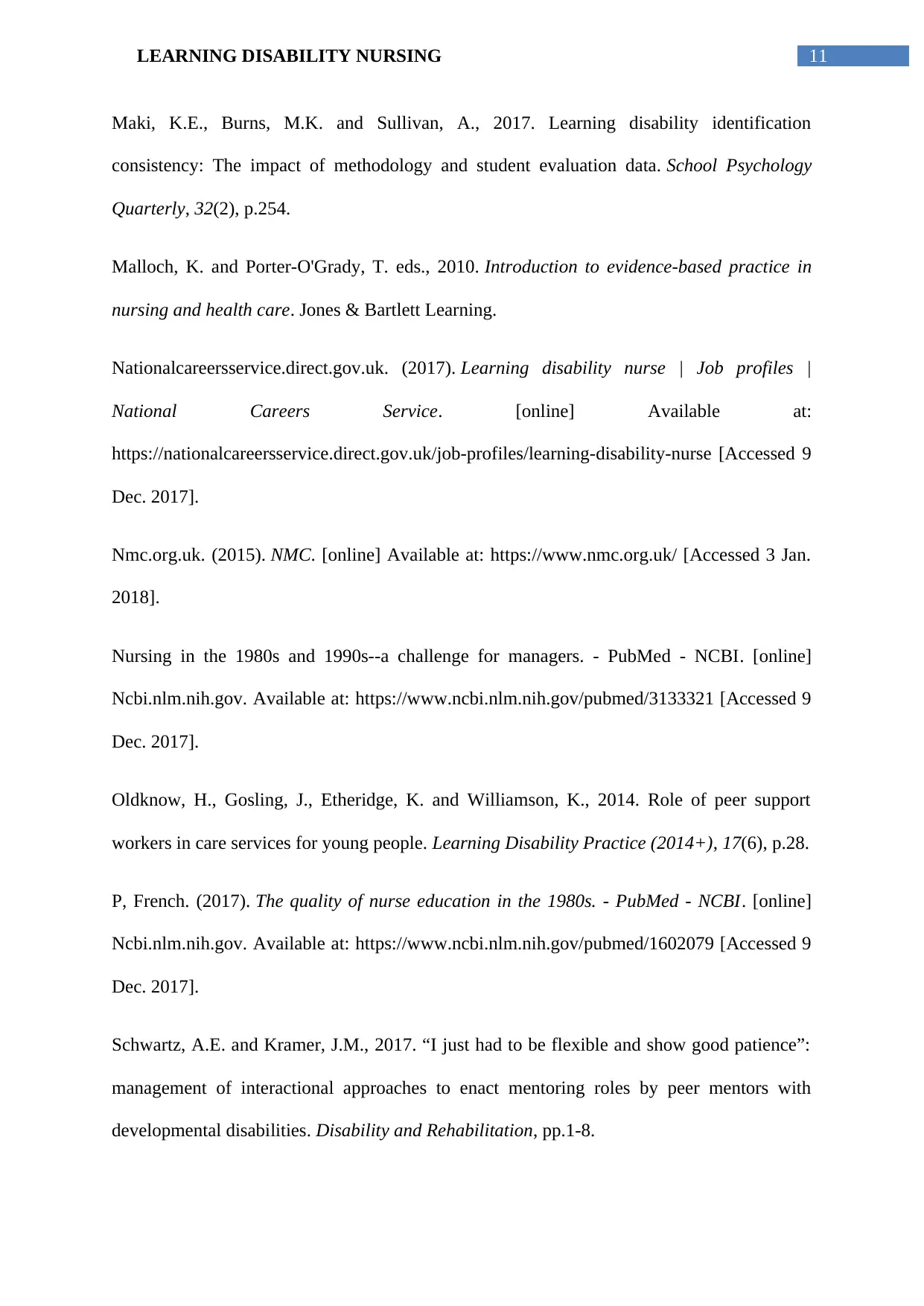
11LEARNING DISABILITY NURSING
Maki, K.E., Burns, M.K. and Sullivan, A., 2017. Learning disability identification
consistency: The impact of methodology and student evaluation data. School Psychology
Quarterly, 32(2), p.254.
Malloch, K. and Porter-O'Grady, T. eds., 2010. Introduction to evidence-based practice in
nursing and health care. Jones & Bartlett Learning.
Nationalcareersservice.direct.gov.uk. (2017). Learning disability nurse | Job profiles |
National Careers Service. [online] Available at:
https://nationalcareersservice.direct.gov.uk/job-profiles/learning-disability-nurse [Accessed 9
Dec. 2017].
Nmc.org.uk. (2015). NMC. [online] Available at: https://www.nmc.org.uk/ [Accessed 3 Jan.
2018].
Nursing in the 1980s and 1990s--a challenge for managers. - PubMed - NCBI. [online]
Ncbi.nlm.nih.gov. Available at: https://www.ncbi.nlm.nih.gov/pubmed/3133321 [Accessed 9
Dec. 2017].
Oldknow, H., Gosling, J., Etheridge, K. and Williamson, K., 2014. Role of peer support
workers in care services for young people. Learning Disability Practice (2014+), 17(6), p.28.
P, French. (2017). The quality of nurse education in the 1980s. - PubMed - NCBI. [online]
Ncbi.nlm.nih.gov. Available at: https://www.ncbi.nlm.nih.gov/pubmed/1602079 [Accessed 9
Dec. 2017].
Schwartz, A.E. and Kramer, J.M., 2017. “I just had to be flexible and show good patience”:
management of interactional approaches to enact mentoring roles by peer mentors with
developmental disabilities. Disability and Rehabilitation, pp.1-8.
Maki, K.E., Burns, M.K. and Sullivan, A., 2017. Learning disability identification
consistency: The impact of methodology and student evaluation data. School Psychology
Quarterly, 32(2), p.254.
Malloch, K. and Porter-O'Grady, T. eds., 2010. Introduction to evidence-based practice in
nursing and health care. Jones & Bartlett Learning.
Nationalcareersservice.direct.gov.uk. (2017). Learning disability nurse | Job profiles |
National Careers Service. [online] Available at:
https://nationalcareersservice.direct.gov.uk/job-profiles/learning-disability-nurse [Accessed 9
Dec. 2017].
Nmc.org.uk. (2015). NMC. [online] Available at: https://www.nmc.org.uk/ [Accessed 3 Jan.
2018].
Nursing in the 1980s and 1990s--a challenge for managers. - PubMed - NCBI. [online]
Ncbi.nlm.nih.gov. Available at: https://www.ncbi.nlm.nih.gov/pubmed/3133321 [Accessed 9
Dec. 2017].
Oldknow, H., Gosling, J., Etheridge, K. and Williamson, K., 2014. Role of peer support
workers in care services for young people. Learning Disability Practice (2014+), 17(6), p.28.
P, French. (2017). The quality of nurse education in the 1980s. - PubMed - NCBI. [online]
Ncbi.nlm.nih.gov. Available at: https://www.ncbi.nlm.nih.gov/pubmed/1602079 [Accessed 9
Dec. 2017].
Schwartz, A.E. and Kramer, J.M., 2017. “I just had to be flexible and show good patience”:
management of interactional approaches to enact mentoring roles by peer mentors with
developmental disabilities. Disability and Rehabilitation, pp.1-8.
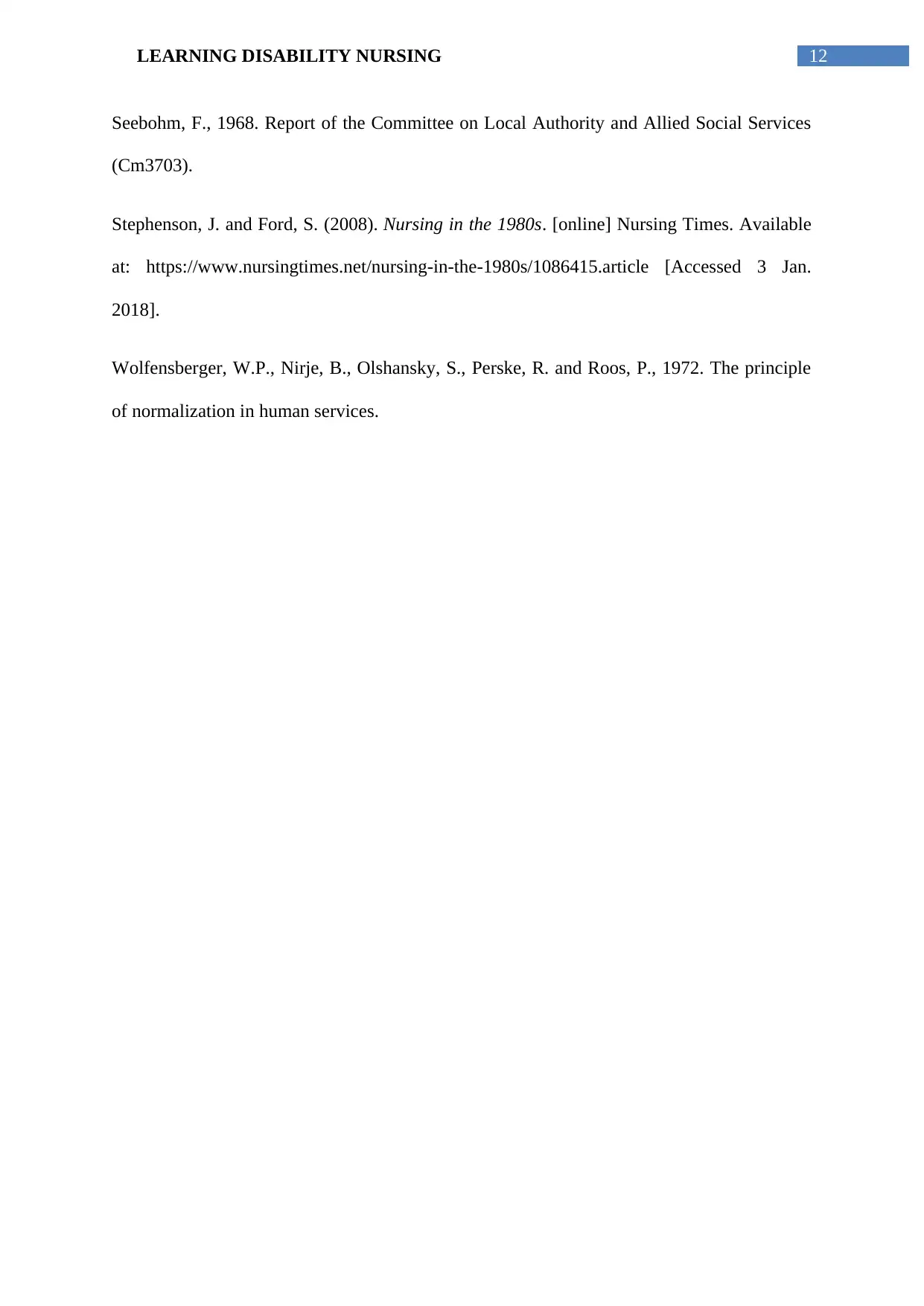
12LEARNING DISABILITY NURSING
Seebohm, F., 1968. Report of the Committee on Local Authority and Allied Social Services
(Cm3703).
Stephenson, J. and Ford, S. (2008). Nursing in the 1980s. [online] Nursing Times. Available
at: https://www.nursingtimes.net/nursing-in-the-1980s/1086415.article [Accessed 3 Jan.
2018].
Wolfensberger, W.P., Nirje, B., Olshansky, S., Perske, R. and Roos, P., 1972. The principle
of normalization in human services.
Seebohm, F., 1968. Report of the Committee on Local Authority and Allied Social Services
(Cm3703).
Stephenson, J. and Ford, S. (2008). Nursing in the 1980s. [online] Nursing Times. Available
at: https://www.nursingtimes.net/nursing-in-the-1980s/1086415.article [Accessed 3 Jan.
2018].
Wolfensberger, W.P., Nirje, B., Olshansky, S., Perske, R. and Roos, P., 1972. The principle
of normalization in human services.
1 out of 13
Related Documents
Your All-in-One AI-Powered Toolkit for Academic Success.
+13062052269
info@desklib.com
Available 24*7 on WhatsApp / Email
![[object Object]](/_next/static/media/star-bottom.7253800d.svg)
Unlock your academic potential
© 2024 | Zucol Services PVT LTD | All rights reserved.





